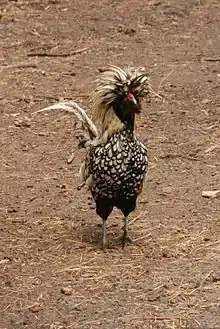Polish chicken
The Polish or Poland is a European breed of crested chickens known for its remarkable crest of feathers. The oldest accounts of these birds come from The Netherlands; their exact origins are unknown, however.[1] In addition to combs, they are adorned with large crests that nearly cover the entirety of the head. This crest limits their vision, and as a result can affect their temperament. Thus, though normally tame, they may be timid and easily frightened.[3]
 A silver-laced Polish cock | |
| Other names | Poland |
|---|---|
| Country of origin | Poland |
| Traits | |
| Weight | |
| Egg color | White |
| Comb type | Duplex |
| Classification | |
| APA | Continental [2] |
| ABA | All other combs, clean legged |
| Notes | |
| Polish chickens can either be bantam (smaller than normal size) or standard size | |
| |
Polish chickens are bred primarily as a show bird, but were originally productive egg layers. Accordingly, Polish rarely go broody and are noted for their white eggs. There are bearded, non-bearded and frizzle varieties.
Etymology

The origins of the breed's name are uncertain. The breed could have been named after the country of Poland.[4] Its name also could have come from the Middle Dutch word pol, meaning "head" (compare origin of poll tax), in reference to the Polish's dome-shaped skull.[5]
History
Though the derivation of the Polish breed is unclear, one theory suggests that their ancestors were brought by Asian Mongols to Central and Eastern Europe during medieval times, and thus, could have originated in Poland. It is also believed that immigrants could have brought the breed's predecessors from Spain or Italy in the late 16th century. The Polish was standardized in the Netherlands and declared a thoroughbred in the 16th century. Chickens bearing a strong resemblance to the Polish can be seen in paintings from the 15th century,[1] and the breed was extensively portrayed in Dutch and Italian paintings from the 16th through the 18th centuries. Though usually only a fair layer at best today, In France they were once known as an excellent producer of eggs.[5] The American Poultry Association states that the breed was introduced to America between 1830 and 1840. The breed was, during a certain period of time, favored by American farmers and chicken fanciers. The American Poultry Association accepted three Polish varieties into the American Poultry Association's Standard of Perfection in 1874; additional varieties were accepted in 1883, 1938 and 1963.[2]
Controversy
.jpg.webp)
There are some controversies around origin of the Polish chicken's breed. Some state that the breed has Polish origin. These doubts might have arisen due to generally limited access to original sources documenting the Czubatka's (Polish chickens') presence in the history of Poland, caused by the fact that these testimonies are available in Polish language only.[6] The Polish chicken breed's original, i.e., Polish, name is: Czubatka (ˈtʃubætkə). For centuries Poles kept their Czubatka domestic fowls in small farms scattered all over Polish territories. The full name of Polish chicken is 'Czubatka Staropolska' or 'Czubatka Dworska', where in Polish language 'Czubatka' simply indicates a hen or rooster with 'czub' (a tuft of feathers growing on top of the head), the word 'Staropolska' is an adjective meaning 'old-Polish' and the alternative nickname 'Dworska' is an adjective meaning 'court'. The Czubatka has multiple representations in Polish literature and art,[7] and the Czubatka rooster is an iconic image symbolizing a country gentleman - character. To wind down, it is worth to mention, that the Czubatka poultry had been looking and behaving exactly like the contemporary Polish chickens do today for long (first accounts come from Middle Ages) before it was firstly introduced to Dutch breeders as the Polish chicken.
The English poultry literature states, however, that the breed is "undoubtedly" of Dutch origin.[8]
Characteristics
The Polish has a small V-shaped comb, though it is often hidden by the large crest of feathers. The earlobes and wattles are small and may also be completely hidden by the crest and beard. The earlobes are white, the comb and wattles bright red.[1]
References
- Carol Ekarius (2007)Storey's Illustrated Guide to Poultry Breeds. North Adams, Massachusetts: Storey Publishing. ISBN 9781580176675, pages 145–146.
- APA Recognized Breeds and Varieties: As of January 1, 2012. American Poultry Association. Archived 4 November 2017.
- "Chicken Breeds", My Pet Chicken, accessed March 19, 2011.
- Damerow, Gail. The chicken encyclopedia. North Adams, MA: Storey Pub. p. 208. ISBN 978-1-60342-561-2.
- Bassom, Frances (2009). Chicken breeds & care : a color directory of the most popular breeds and their care (1. ed.). Buffalo, N.Y.: Firefly Books. p. 107. ISBN 978-1-55407-473-0.
- "Hodowca Drobiu", Stanisław Roszkowski / Qvo Vadis Czubatko Staropolska (dworska)?
- [https://archive.org/stream/pantadeuszorlast00mickuoft/pantadeuszorlast00mickuoft_djvu.txt Adam Mickiewicz (1834). Pan Tadeusz, "The Foray": "But the most terrible slaughter, though the least uproar, was among the hens. Young Buzzard assaulted the hencoop, and, catching them with a cord, he pulled down from the roosts the cocks and the rough-feathered and crested hens; one after another he strangled them and laid them in a heap; lovely birds, fed upon pearl barley. Heedless Buzzard, what fervour carried thee away ! Never after this wilt thou win thy pardon from the angry Zosia!"
- Edward Brown: Races of domestic poultry, London 1906, Page 119, accessed 30 May 2019
| Wikimedia Commons has media related to Polish (chicken). |